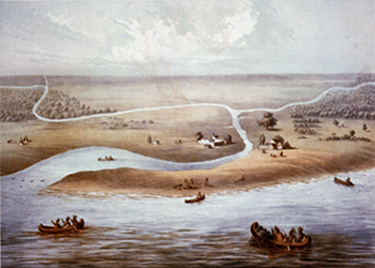Indian country was never the same following the War of 1812. If Native aspirations were to maintain their land base and relative autonomy, then the war was most of all a loss for Native peoples throughout eastern North America. This is most clearly evident in the Great Lakes region.
In the Great Lakes region the space for viable, long-term indigenous resistance to US expansion had closed by 1815. By no means, however, had the Native peoples of the region lost the power to control their own fate.

Library of Congress, Photographs and Prints Division
The Treaty of Ghent, which ended the War of 1812, signaled the demise of the imperial play-off system in which Native people had pitted European powers against one another to leverage the greatest advantage for themselves. For nearly two centuries, the Great Lakes region was what historian Richard White has labeled a “middle ground” between Algonquian Indians and European empires, in which both groups mutually benefited from their relationship and neither party could fully impose its will upon the other. Within this dynamic, Native peoples held equal sway in the balance of power and maintained autonomy: whites needed Indians, used them, and attempted to understand and accommodate their cultures—and vice versa. In American Indian history, 1815 marks the turning point when the middle ground gradually began to erode once the Americans assumed control of the Great Lakes region. The conclusion of the war and the eventual dissolution of the middle ground opened the door to both a US policy of Indian removal as well as numerous Indian land cessions, two of the most apparent and disruptive legacies of the War of 1812.
The nature of the middle ground itself changed over time. In its first phase, the middle ground was an Algonquian-French symbiosis that kept the region from erupting into violent conflict through accommodation, gift-giving, and peaceful exchange. This symbiosis endured until the aftermath of the French and Indian War (1754–1763). In 1763 the British acquired France’s territory, and their newly imposed policies that rejected mediation with Indians sparked an uprising of Great Lakes tribes against British rule. Led by an Ottawa chief, Pontiac’s Rebellion served as a powerful reminder to the British that their economic and military success in the region depended upon cultivating their own middle ground with the Algonquian peoples. Following the reestablishment of the middle ground and the beginning of the American Revolution a decade later, British and Indian ties grew stronger as they shared a common enemy in the Americans. In the immediate aftermath of the War of 1812, British agents and traders still exercised a great degree of influence throughout the Great Lakes region. It was nearly a decade before the British and Indian bonds were weak enough for the United States to establish dominion in the region.
The death of Tecumseh—the Shawnee leader who, along with his younger brother Tenskwatawa, assembled a multi-tribal confederacy during the War of 1812 that resisted American encroachment—marked the passing of complete Indian autonomy east of the Mississippi River. Among the Menominee Indians of Wisconsin, the respected war chief Tomah fought alongside the British to defend Mackinac Island from the Americans in 1814. Three years later, after the Americans assumed control of the region, Tomah apparently died from alcohol poisoning while in a state of depression on the island. Though some Plains tribes such as the Lakota would not reach the height of their power for decades, in the Great Lakes region the space for viable, long-term indigenous resistance to US expansion had closed by 1815. By no means, however, had the Native peoples of the region lost the power to control their own fate.
Last updated: August 14, 2017
